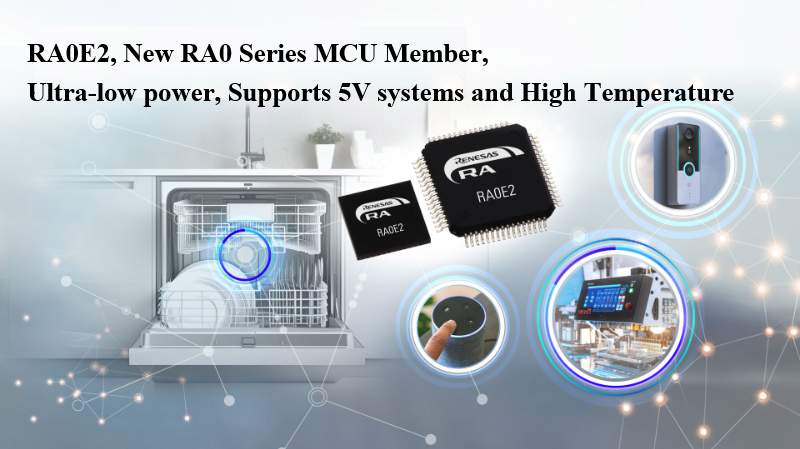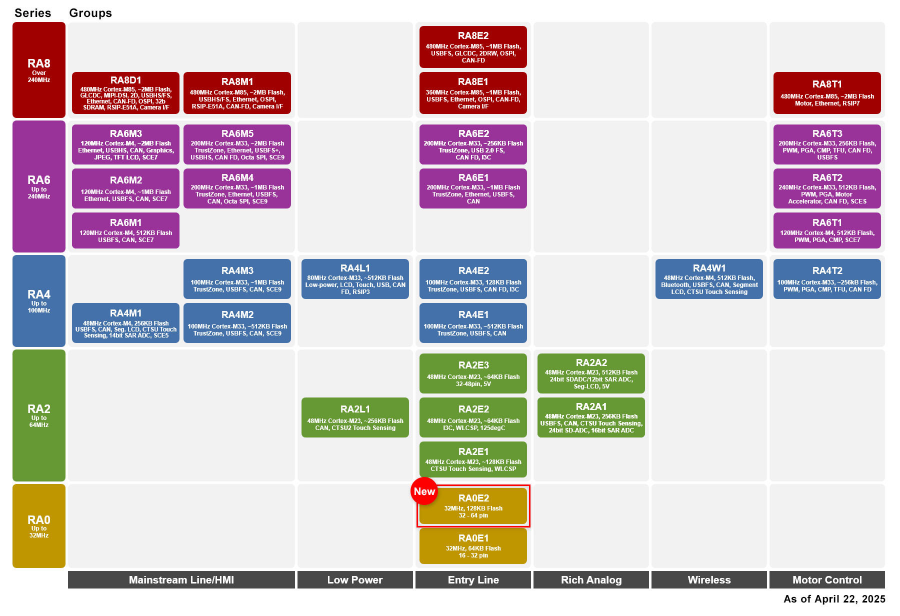Renesas Launches RA0E2 Ultra-Low Power MCUs for 5V Systems, Industrial Control, and Consumer Electronics
2025-04-27 11:47:03 707
Affordable RA0E2 for Building Automation, Industrial Systems Control, Small Appliances, and Consumer Electronics
April 22, 2025, Beijing, China Global semiconductor solutions provider Renesas Electronics Corporation (TSE: 6723) today announced the release of the Arm?Cortex?-M23 processor-based RA0E2 microcontrollers (MCUs). Significant cost competitiveness, incredibly low power consumption, a greater temperature range, several peripheral functions, and dependable security features are all offered by this new product line.

Figure. 1
In 2024, Renesas introduced the RA0 MCU series, which has since gained popularity among consumers due to its low-cost and low-power characteristics. Consumer electronics, household appliances and white goods, power tools, industrial monitoring and control, and many more areas have made extensive use of the RA0E1.
By increasing the pinout and keeping the same peripherals and extremely low power consumption, the RA0E2 MCUs are compatible with the RA0E1 products. Customers can reuse pre-existing software resources thanks to this compatibility. With its integrated high-speed on-chip oscillator (HOCO), the new product offers industry-leading low power consumption of just 2.8mA in operating mode and 0.89mA in sleep mode. This allows the RA0 MCUs to stay in software standby mode for extended periods of time, further reducing power consumption to just 0.25μA.
For battery-powered consumer electronics, small appliances, industrial system control, and building automation applications, Renesas' RA0E1 and RA0E2 ultra-low-power MCUs provide the perfect solution.
Low-cost function set optimization
For applications where cost is a concern, the RA0E2 feature set has been meticulously optimized. Customers do not need to install extra level shifters or regulators in a 5V system since it has a broad operating voltage range of 1.6V to 5.5V. RA0 MCUs lower clients' BOM costs by integrating timers, serial connectivity, analog operations, functional safety functions, and a data security mechanism. A 5mm by 5mm 32-pin QFN small package is one of the several package types that are offered.
Designers no longer need to employ a separate oscillator thanks to the new MCUs' high-precision (±1.0%) HOCO, which also greatly increases baud rate accuracy. Customers can avoid expensive and time-consuming "fine-tuning" procedures even after reflow because the HOCO, in contrast to other HOCOs, retains this precision in temperatures ranging from -40°C to 125°C.
"The RA0 family of products has far exceeded our initial expectations, while the RA0E2 product group of MCUs offers ultra-low power consumption and price advantages, along with a wider temperature range," stated Daryl Khoo, Vice President of the Embedded Processing Marketing Division at Renesas. More application scenarios and cases will be made possible by the RA0E2 product group MCUs' ultra-low power consumption, price advantage, wider temperature range, and greater memory capacity. We plan to further expand the RA0 product lineup to provide the best solution for users transitioning from 8-16-bit MCUs to 32-bit MCUs.”
Key features of the RA0E2 product group MCUs
Core: 32MHz Arm Cortex-M23;
Storage: up to 128KB of code flash and 16KB of SRAM;
Extended temperature range: -40°C to 125°C;
Timer: Timer Array Unit (16-bit x 8 channels), 32-bit Interval Timer (8-bit x 4 channels), RTC;
Communication peripherals: 3 UARTs, 2 asynchronous UARTs, 6 simplified SPIs, 2 I2Cs, 6 simplified I2Cs;
Analog peripherals: 12-bit ADC, temperature sensor, internal reference voltage;
Functional safety: SRAM parity check, invalid memory access detection, frequency detection, A/D test, output level detection, CRC calculator, register write protection;
Data security: unique ID, TRNG, AES bank, flash read protection;
Packages: 32-pin and 48-pin QFN; 32-pin, 48-pin and 64-pin LQFP.

Figure. 2 Renesas RA Family MCU Product Lineup
The Flexible Configuration Software Package (FSP) from Renesas powers the new RA0E2 family of MCUs. By offering all the infrastructure software required for development, such as multiple RTOSes, BSPs, peripheral drivers, middleware, connectivity, networking, and security stacks, as well as reference software for creating intricate AI, motor control, and cloud solutions, the FSP speeds up the development of applications. It gives users complete application development flexibility by enabling them to connect their preferred RTOS and current code with FSP. Depending on their requirements, customers can quickly switch from existing RA0E1 designs to the bigger RA0E2 series with FSP.
The MCU Advantage of Renesas
In recent years, Renesas MCUs, the world's top provider of MCU devices, has sold an average of more than 3.5 billion units annually. About half of these are employed in the automotive sector, with the remaining ones being used in industrial, data center, communication infrastructure, and Internet of Things applications. Renesas provides a large selection of 8-, 16-, and 32-bit products that are outstanding in terms of effectiveness, performance, and quality. Renesas Electronics is also a dependable supplier thanks to its decades of experience creating MCUs, dual-source manufacturing strategy, industry-leading MCU process technology, and extensive network of more than 250 ecosystem partners.
About Renesas Electronics
With technology making life easier, Renesas Electronics (TSE: 6723) is dedicated to creating a more secure, intelligent, and sustainable future. Renesas Electronics, a global producer of microcontrollers, offers comprehensive semiconductor solutions by fusing its knowledge of embedded processing, analog, power, and connection. The prosperous product line expedites the release of automotive, industrial, infrastructure, and Internet of Things applications, enabling billions of smart objects to be connected and enhance people's lives and work.




